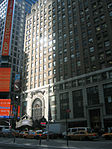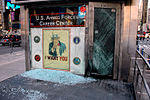Paradise Roof Garden

Hammerstein's Roof Garden (1899–1915) was the official name of the semi-outdoor vaudeville venue that theatre magnate, Oscar Hammerstein I, built atop the Victoria Theatre and the neighboring Theatre Republic, commonly known then as the Belasco Theatre. Unlike Hammerstein’s first roof garden theatre, which crowned his failed Olympia Theatre, the Paradise Roof Garden was able to rise to prominence and contend with its rivals for the better parts of two decades. For New York City theatre-goers, the name Hammerstein’s grew to encompass both the Victoria and its roof garden. From 1904 to 1914 it was run by Willie Hammerstein, who put on highly popular vaudeville acts.
Excerpt from the Wikipedia article Paradise Roof Garden (License: CC BY-SA 3.0, Authors, Images).Paradise Roof Garden
West 44th Street, New York Manhattan
Geographical coordinates (GPS) Address Nearby Places Show on map
Geographical coordinates (GPS)
| Latitude | Longitude |
|---|---|
| N 40.756761 ° | E -73.986528 ° |
Address
Times Square
West 44th Street
10036 New York, Manhattan
New York, United States
Open on Google Maps









